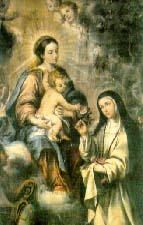[ INFO ] | [ VJ CONSOLE ] | [ CONCERTS ] | [ INSTALACION ] | [ DOWNLOAD AUDIO ] |
|
TEMPORAL DE SANTA ROSA "Isabel
Flores de Oliva nació en Lima, Perú, el 30 de abril
de 1586 y murió la madrugada del 24 de agosto de 1617. Según la historia, en 1615 ante la proximidad del enemigo frente a las costas, la autoridad eclesiástica dispuso se elevaran rezos en todos los monasterios. Rosa, desde la capilla de San Gerónimo elevaba sus ruegos. Pronto una gran tormenta impidió el desembarco del enemigo y la ciudad quedo a salvo. Los más fieles creyentes atribuyeron la tormenta a los ruegos de Rosa. En
la región del Río de la Plata, la devoción
por Santa Rosa de Lima era muy profunda. Próxima a la época primaveral, a fines de agosto y principios de setiembre, las masas de aire cálido de origen subtropical, cargadas de humedad y con temperaturas templadas a cálidas, llegan hasta latitudes cercanas al Río de la Plata. En tanto, la masa de aire frío de origen polar o subpolar, aun conservan la energía suficiente para alcanzar con fuerza las mismas latitudes. Se
incrementa entonces la actividad asociada al desplazamiento de estos
frentes, y como resultado, se producen lluvias acompañadas
de tormentas eléctricas si los sistemas son intensos. Esta
situación es bastante frecuente cada año por lo que
no resulta extraño que unos días antes de la fecha
de Santa Rosa o unos días después, la tormenta se
haga presente.
. . . . . .
// Relación Señal/Ruido Las grabaciones de la interferencia electrica [radioestática] ocasionada por la proximidad/presencia del temporal de Santa Rosa en diversas radiofrecuencias, fueron realizadas entre el 20 de agosto y el 8 de setiembre del año 2002, en Montevideo-Uruguay. La presencia de la tormenta es, de esta manera, reflejada por el 'ruido' presente en la señal, siendo este 'ruido', paradojicamente, la 'señal' que nos interesa: la que nos define la informacion. La existencia misma del temporal. Asi como los radio-operadores utilizan el CQ ['CHARLIE-QUEBEC/llamado general a todas las radioestaciones en escucha'] para mejorar la sintonia de la señal y poder recibir mejor el mensaje, se recomienda utilizar el track 1/CQ CQ CQ para 'sintonia' del audio general del CD [i.e ecualizacion y volumen personalizado]. . . . . . . |
|
STORM OF SANTA ROSA "Isabel Flores de Oliva was born in Lima, Peru, the 30th of April of 1586 and died the dawn of 24th of August of 1617. She was beatified with the name of Rosa. Santa Rosa of Lima is patron of the Catholic Church on hispano-america and the Philippines, and her celebration day is on the 30th of August. According
to history, in 1615, due to the proximity of the enemy coming from
the sea, the ecclesiastical authority arranged prayers in all the
monasteries. Rosa, from the chapel of San Gerónimo elevated
her prayers... In
the region of Rio de la Plata, the devotion of Santa Rosa de Lima
was very deep. By the end of August and beggining of September [near springtime], warm air masses of subtropical origin, loaded with humidity and warm temperatures, arrive to latitudes next to Rio de la Plata. At the same time, cold air mass of polar or subpolar origin, powerfully reaches the same latitudes. The activity associated to the displacement of these fronts is increased, and as a result, rains accompanied by electrical storms take place. This situation is frequent every year, being this the reason why is not so strange that few days before or after the 'Day of Santa Rosa', this storm is present. Popular belief to associate this meteorological phenomenon with Santa Rosa is very extended in both margins of Rio de la Plata. "
. . . . . // Signal to Noise Ratio Recordings of radiostatics [electrical interferences on radiofrequencies] caused by the proximity/presence of the 'Tormenta de Santa Rosa', were carried out between the 20th of August and the 8th of September 2002, in Montevideo-Uruguay. The presence of the storm is thus unveiled by the 'noise' present within the signal. Paradoxically, this 'noise' is the 'signal' which defines the information to us: The existence of the storm itself. As the radio-operators use the CQ call [ CHARLIE-QUEBEC / 'general call to all radiostations' ] to improve/fine-tune the reception of the signal, it is recommended to use Track 1/CQ CQ CQ for 'overall sintonization' of the audio on this CD [customized volume & equalization]. . . . . . .
brian
mackern |
